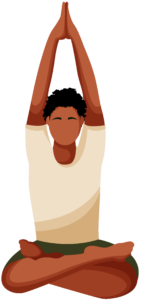Seated Mountain (Parvatasana)
Pose Overview
| Common Name | Seated Mountain |
| Traditional Sanskrit Name | Parvatasana |
| Sanskrit Name Pronunciation | pur-vuh-TAHS-uh-nuh |
| Pose Difficulty | Beginner |
| Drishti
Drishti is the gaze or visual focus point during yoga poses.
Learn more about Drishti |
Straight ahead or the nose |
Seated Mountain Pose, or Parvatasana in Sanskrit, is a seated yoga posture that is often used to build strength and stability in the body. This pose is considered a foundational pose in many yoga traditions and is often used as a starting point for more advanced postures. It is a simple, yet effective pose that can be practiced by yogis of all levels, from beginners to advanced practitioners.
Benefits of Seated Mountain
This pose helps to build strength in the legs, core, and back, as well as improving posture and balance. It also helps to relieve stress and tension in the body, and is a great way to prepare the body for more advanced postures. Additionally, it can help to improve digestion and stimulate the kidneys and liver.
How to Enter Seated Mountain
Start by sitting on the floor with your legs straight out in front of you. Sit up tall, with your spine straight and your shoulders back. Place your hands on your knees and breathe deeply.
How to Exit Seated Mountain
To exit the pose, simply release your hands from your knees and come out of the pose.
Common Seated Mountain Modifications & Variations
Some modifications to this pose include using a folded blanket or cushion to sit on to help raise the hips and make the pose more comfortable. Another variation is to cross the legs, coming into a more restful seated position.
Common Mistakes with Seated Mountain
One common mistake in this pose is letting the spine round forward, which can put unnecessary strain on the back. It is important to keep the spine straight and the shoulders back.
Safety Guidance
It is important to keep the spine straight and the shoulders back while in this pose to avoid putting unnecessary strain on the back. Additionally, people with knee injuries should be careful when practicing this pose.

